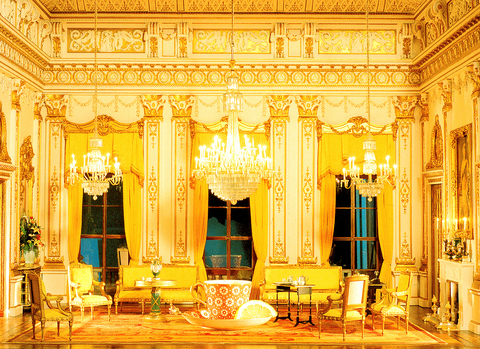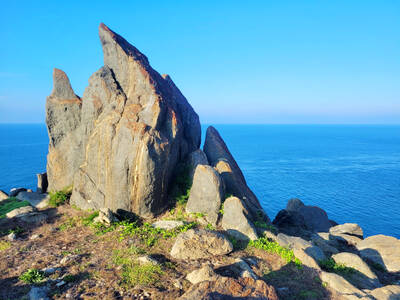Screaming kindergartners crawl through a smoke-filled hallway, searching for the exit. Later in a room downstairs, they duck under a table as the floor shakes beneath them. Meanwhile, a dozen high school students clamber out a window and descend a fire escape.
These aren't scenes from an earthquake. This is the Taipei Fire Department's Fire Safety Museum (防災科學教育館). And by all accounts the kids love it.
"They also like playing with the fire extinguishers," Kang Jin-shan (康金山) , a museum guide, said of the thousands of students who visit each year to learn what to do when disaster strikes.

PHOTO COURTESY OF MINIATURE MUSEUM OF TAIWAN
Taipei is known for its National Palace Museum, and exhibits at its Fine Arts Museum occasionally attract international coverage. Not so famous but in some ways more intriguing are the city's dozens of museums and galleries devoted to odd topics such as paper, contraband and old Chinese battles.
A few of these institutions would probably not exist if not for field trips and government subsidies, but many are worth a visit and offer unique perspectives on life in Taiwan.
Such as the museum for tap water. Yes, tap water.
The Taipei Museum of Drinking Water (自來水博物館) reopened in 2000 after NT$80-million worth of renovations. Its original attractions included a Baroque-style museum building that was built to house water pumps, and a collection of decommissioned valves, faucets and circuit boards.
The vintage technology is still inside the building, which was built in 1908 and is now a third-class historic site. On a recent visit, couples posed for wedding pictures outside while long lines of schoolchildren waited for a peek at 1950s Hitachi and Allis-Chalmers pumps under the museum's vaulted ceiling.
"In other countries, water treatment facilities aren't open to the public," noted Wu Neng-hung (吳能鴻) the museum's director.
But what really sets this place apart from the like-minded, but more sober institutions run by other government agencies is the result of the renovations. Wu said the complex attracted 330,000 visitors last year.
The adjacent Taipei Water Park (台北自來水園區) features hiking trails for grownups, a large jungle gym with slides and water cannons in a shallow pool, and a concrete stream that winds through gushing fountains and is safe enough for toddlers to wade in. The kids will have so much fun they won't even notice if they learn a thing or two in the new learning center.
"I hope that (visitors) will understand where tap water comes from," Wu said. "Every stage in the process is very difficult. Although our water is cheap, it's also very precious."
On the opposite end of the scale, in terms of size and utility, is the Miniature Museum of Taiwan (袖珍博物館), a private institution tucked away in the basement of a high rise on Jianguo North Road.
Unlike other museums that showcase models and replicas, the miniatures in this gallery are, as much as possible, made of the same materials used in the real-life objects they represent. The museum is the first of its kind in Asia and attracted 100,000 visitors last year, said guide Chen Sheng-yi (陳生儀).
Among the highlights is a replica of a 19th-century Californian mansion, which took an American who was getting his PhD in architecture four years to complete. Walls of the "Rose Mansion" are cut away to reveal scenes from domestic life: the master of the house entertaining a woman in the bedroom, a spread of desert and champagne on ice, a tiny pool table with billiard balls and a cue stick.
"I don't have space for this at home," said Vicky (謝曉汶), a 22-year-old tourist from Hong Kong who had been admiring the model. Her arms fluttering with excitement, she said: "The decorations are very detailed. The painting is good, too."
Unlike the drinking water museum, the majority of the visitors here are tourists. Most come from Singapore, Hong Kong and Malaysia, Chen said.
Just as conservation and lack of space are concerns in Taipei's crowded urban environment, so too are earthquakes and typhoons.
The Fire Safety Museum draws more than 60,000 visitors each year, Kang said, and teaches them how to deal with natural disasters and man-made incidents such as fires and car accidents.
In the earthquake room, children are instructed to don hard hats, turn off a gas meter and open the door before crouching under a table. In the smoke room, they practice ducking below the smoke and crawling towards the exit. There are also phones with computer terminals where kids learn how to dial 119. A test at the end reminds them only to use the service during emergencies.
And it's free. Unfortunately, high school students and adults can't use the earthquake room. Not to worry. For them there are the fire escape and the typhoon chamber, which is rigged with metal rails for visitors to hang on to while they are subjected to strong currents of air and a torrents of water. The museum supplies raincoats and boots. The less adven-turous can watch through a glass wall as those inside get buffeted and splashed.
Conditions in the room are similar to those during a medium-force typhoon. "I don't know how strong the wind is," Kang said, "but it's pretty strong."
MUSEUM NOTES:
Taipei Water Park:
● 1 Siyuan St, Taipei
● Open Tuesdays through Sundays, 9am to 6pm. Ticket booth closes at 5pm; Tel: 02 8369 5145
Miniature Museum of Taiwan:
● B1, 96 Jianguo N Rd, Taipei
● Open Tuesdays through Sundays, 10am to 6pm. Purchase tickets before 5pm; Tel: 02 2515 0583
Fire Safety Museum:
● 37 Chenggong Rd Sec 2, Neihu, Taipei (台北市內湖區成功路二段37號)
● Open Tuesdays through Sundays, from 9am to 12pm and from 2pm to 5pm. Only groups of 15 or more, which must call in advance, can use facilities such as the typhoon room; Tel: 02 2791 9786

June 9 to June 15 A photo of two men riding trendy high-wheel Penny-Farthing bicycles past a Qing Dynasty gate aptly captures the essence of Taipei in 1897 — a newly colonized city on the cusp of great change. The Japanese began making significant modifications to the cityscape in 1899, tearing down Qing-era structures, widening boulevards and installing Western-style infrastructure and buildings. The photographer, Minosuke Imamura, only spent a year in Taiwan as a cartographer for the governor-general’s office, but he left behind a treasure trove of 130 images showing life at the onset of Japanese rule, spanning July 1897 to

One of the most important gripes that Taiwanese have about the Democratic Progressive Party (DPP) is that it has failed to deliver concretely on higher wages, housing prices and other bread-and-butter issues. The parallel complaint is that the DPP cares only about glamor issues, such as removing markers of Chinese Nationalist Party (KMT) colonialism by renaming them, or what the KMT codes as “de-Sinification.” Once again, as a critical election looms, the DPP is presenting evidence for that charge. The KMT was quick to jump on the recent proposal of the Ministry of the Interior (MOI) to rename roads that symbolize

On the evening of June 1, Control Yuan Secretary-General Lee Chun-yi (李俊俋) apologized and resigned in disgrace. His crime was instructing his driver to use a Control Yuan vehicle to transport his dog to a pet grooming salon. The Control Yuan is the government branch that investigates, audits and impeaches government officials for, among other things, misuse of government funds, so his misuse of a government vehicle was highly inappropriate. If this story were told to anyone living in the golden era of swaggering gangsters, flashy nouveau riche businessmen, and corrupt “black gold” politics of the 1980s and 1990s, they would have laughed.

It was just before 6am on a sunny November morning and I could hardly contain my excitement as I arrived at the wharf where I would catch the boat to one of Penghu’s most difficult-to-access islands, a trip that had been on my list for nearly a decade. Little did I know, my dream would soon be crushed. Unsure about which boat was heading to Huayu (花嶼), I found someone who appeared to be a local and asked if this was the right place to wait. “Oh, the boat to Huayu’s been canceled today,” she told me. I couldn’t believe my ears. Surely,